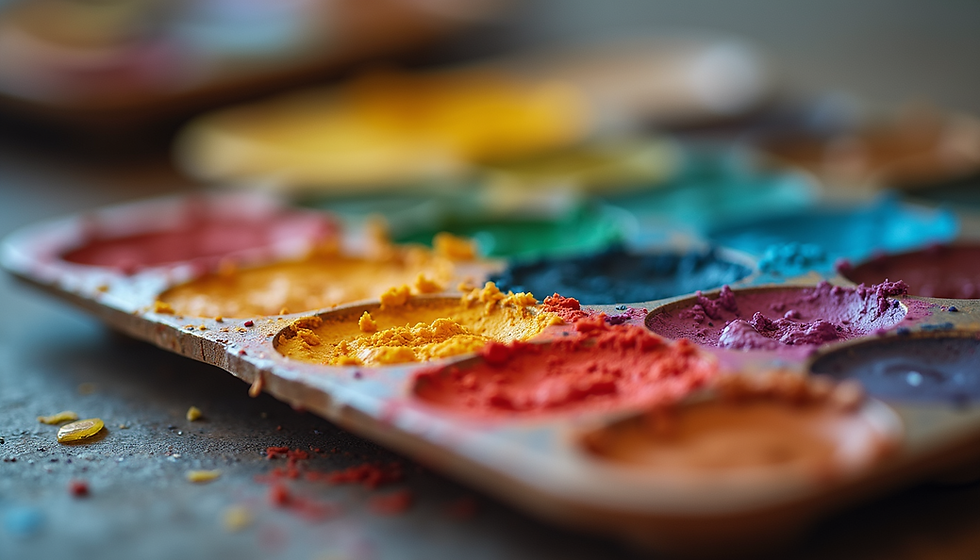Discovering Your Unique Artistic Voice
- Kriti Tiwari - lostloveforart

- Oct 22
- 4 min read
Finding your artistic voice is a journey that every artist embarks on. It's a process of self-discovery, creativity, and personal expression. Your artistic voice is what sets you apart from others; it's the unique perspective you bring into your work. In this blog post, we'll explore how to discover and nurture your artistic voice effectively.
What is Your Artistic Voice?
Your artistic voice is a combination of your style, techniques, and emotional expression. It reflects your unique way of seeing the world. Just like a musician has a distinct sound, artists have a unique visual language. This can involve your choice of colors, composition, themes, and even the emotions you aim to evoke in your audience.
Artistic voice evolves over time and can be influenced by various factors. These include cultural background, personal experiences, and the artistic movements that resonate with you. Understanding what your artistic voice is helps you create more meaningful and authentic work.

Developing Your Artistic Voice
Begin the journey of discovering your artistic voice by exploring various forms of art. Engage with different mediums, from painting to sculpture to photography. This exploration will help you identify the techniques and materials that resonate with you.
Experimentation is Key
Try new things. Create art that challenges your skills and pushes your boundaries. Don’t fear making mistakes; they can lead to breakthroughs. Use different materials and try abstract vs. realistic styles. One of the best ways to discover your artistic voice is through experimentation.
Reflect on Your Interests
What subjects captivate you? Whether it's nature, social issues, or urban landscapes, your interests greatly impact your artistic voice. Spend time reflecting on your passions. Keep a journal where you jot down ideas, feelings, and inspirations. This regular reflection helps you gain clarity about your artistic inclinations.

How do artists get their inspiration?
Artists draw inspiration from various sources. Some derive inspiration from nature, while others may find it in literature, music, or even personal experiences. Here are some effective ways to seek out inspiration:
Explore Your Surroundings
Take long walks in your local area. Observe the colors, textures, and shapes in everyday life. Consider capturing photographs as references for your artwork. Urban settings, rural landscapes, and even crowded coffee shops can ignite creativity.
Engage with Other Artists
Networking with fellow artists can provide fresh perspectives. Join local art groups or participate in workshops. Sharing ideas and feedback can stimulate inspiration; you may find that others resonate with your vision or offer new insights that you hadn't considered.
Study Influential Artists
Look into the works of artists that you admire. Try to understand their techniques, themes, and the emotions they convey. This doesn’t mean you should copy their style, but studying their processes can help inform your development.

Overcoming Creative Blocks
Every artist faces creative blocks at some point. Here are actionable strategies to navigate through these periods:
Take Breaks
Sometimes, stepping away from your work can reignite your creativity. Go for a hike, read a book, or try a new hobby. These breaks can provide a fresh perspective on your work.
Set Limitations
Imposing limitations on yourself can boost creativity. Choose a restricted color palette, limit the materials you use, or set a time limit for creating. Constraints often spark innovative approaches.
Start with Something Small
If you're feeling overwhelmed, focus on small projects. Create quick sketches or mini paintings. These shorter tasks can help shift your mindset and make it easier to dive back into larger projects.
Finding Your Audience
As you develop your artistic voice, it’s important to identify who your audience is. Knowing your audience can help tailor your work while remaining true to your voice.
Research Different Communities
Explore online platforms, local galleries, and social media. Join forums or groups related to your specific art style. These spaces help you connect with potential viewers and gain feedback on your work.
Ask for Feedback
Don’t hesitate to reach out for critiques. Constructive feedback can offer guidance and reveal blind spots in your work. Seek support from trusted friends or mentors who understand your artistic journey.
Share Your Process
Sharing your creative process can engage your audience deeper. Document your journey through videos or blog posts. It helps viewers appreciate not only the final piece but the effort and thought behind it.
Continuing the Journey
Finding your unique artistic voice is just the beginning. It’s crucial to remain committed and open to growth. The journey of self-discovery in art is never-ending; there will always be room for new experiences and influences.
Keep looking for inspiration for artists by exploring, learning, and creating. The world is full of ideas waiting to be translated into your own voice. Always remember that your artistic voice will continue to evolve. Embrace the changes, and let them guide you in your creative pursuits.
As you continue to develop your artistic voice, stay patient and curious. Each artwork you create adds another layer to your identity as an artist. Trust the process, and let your unique perspective shine through.
With consistency and dedication, your artistic voice will emerge more distinctively over time, allowing you to create works that resonate deeply both with you and your audience.



Comments